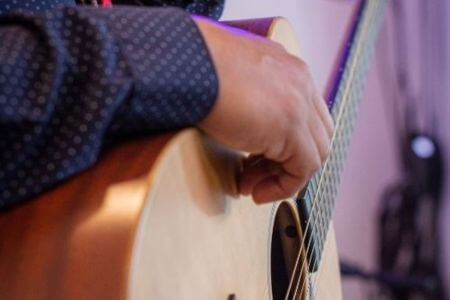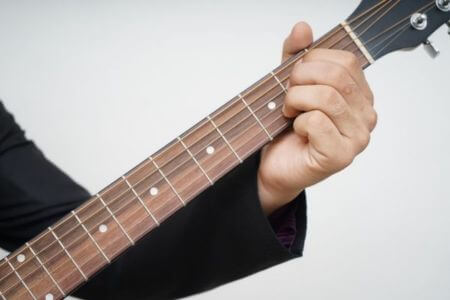How to Practice Guitar Through an Injury | 3 Methods
If you’re dealing with a guitar-related injury, you’re definitely not alone. In fact, many if not most guitarists report that they’ve had to deal with an injury at some point.
This post is all about how to keep practicing despite guitar-related injuries. I believe that, generally speaking, injuries shouldn’t prevent guitarists from continuing to practice.
However, this doesn’t mean you should play through your injury. Rather, that you should pursue alternatives to normal physical practice such as working with one hand alone, listening to music, or using visualization.
Hopefully, at least one of these strategies will work for you. Consistent practice is absolutely key to improving at guitar, so if you can keep going despite an injury, you should give it a shot!
1) Focus on Your Other Hand
Chances are, your injury affects one of your hands but not the other. For example, if you’re having problems with your left wrist, then you can still do some right hand work, and vice versa.
The good news is that isolating one of your hands is actually a great mode of practice. Most guitar players practice with both hands all of the time, never quite mastering the movements of either one. If you slow things down and look closely at what one hand is doing, you’re a lot more likely to notice inefficiencies in your technique.
I would even go so far as to say that the less you practice at once, the better. This applies not only to isolating one hand at a time (in this case, your healthy hand) but also to your approach to learning music. It’s often much better to learn a song one measure at a time, for instance, than to practice the entire thing at once.
How Do You Practice with Your Right Hand Alone?

Your right hand (or your plucking/picking hand) is much easier to isolate than your left (or fretting) hand. The key is to stick to your normal practice habits except play open strings instead of fretted ones.
If you’re working on fingerstyle scales, you might work on alternating between your middle and ring fingers, your thumb and first finger, your first and third finger, or any other combination you normally neglect.
If you’re playing with a pick, you can either practice strumming or work on picking individual strings.
You might even gain a new appreciation for your right hand. I think we’re all quick to appreciate the dance of the left-hand fingers, but we shouldn’t forget that our right hand is (usually) responsible for our sound!
There’s no reason you can’t also work on your normal repertoire using this method. Simply relax your left hand and focus on the work your right hand needs to do to move through a piece.
You might even realize that a certain passage you assumed was a left-hand issue is in fact a right-hand issue, and be able to untangle it with right-hand work alone.
critically examine your tone
You can also use this as an opportunity to take a closer look at your quality of sound. If you’re playing with a pick, are you happy with its action against the strings? You might find that you tend to pick either too forcefully or too gently. In either case, you should work on your control. You might also realize that your pick is too thick or thin for your taste. I’d encourage you to experiment with a few different types of picks. Consider doing some research into picks that work best for the style of music you’re studying.
If you’re playing fingerstyle, you might examine the quality of your strokes. Is your sound mellow or bright? Full or thin? Are you able to control your dynamics across a piece, or do you often pluck too lightly when you should be in a crescendo? Do you prefer playing with your fingertips or your nails? Each has its advantages and disadvantages, so don’t be afraid to try both and see for yourself.
How to Practice With Your Left Hand Alone

There are a number of ways to isolate your left hand. If you’re having an issue with your right hand, there’s usually no reason you can’t press forward with your left, addressing a host of issues you might be neglecting with your normal routine.
Often the best left-hand workout consists in practicing hammer-ons and pull-offs. You don’t need to be working on a piece of music that features these slurring techniques either. Rather, you ought to be willing to pull out your guitar and spend fifteen minutes hammering-on with each of your left-hand fingers.
Always practice most with your pinky and ring finger, as these are naturally weaker than your index and middle fingers!
Another option for you is to practice changing chords without actually playing them. You can gain a lot by shifting back and forth between chord shapes for a few minutes. If you strum each chord, you’re a lot more likely to get lost in the music and forget the point of your session—to master a certain chord change.
If you’re dealing with a chord shape that feels especially foreign to your fingers, you might familiarize yourself with it by holding the shape for a minute or two, relaxing, and then holding it again.
I’ve noticed that the more I hold any given chord, the more comfortable my fingers feel in that shape, and the quicker they can switch in and out of it when needed.
2) Listen to Music While Following the Score
Suppose the worst has come to pass: for some reason or another, neither one of your hands is available to play guitar. You might be dealing with multiple injuries, or you might be in a situation that makes playing impossible. Either way, if you’re still feeling motivated to improve at guitar, you need to find a way to practice.
Fortunately, you can practice effectively without touching your guitar! Perhaps the easiest way to do this is to listen to music, ideally while following along with the written notation.
Of course, this method works best if you can read some kind or notation. I know that many guitarists don’t read music, but most can at least read tablature. So even if you’re the type of player who relies on tabs, don’t hesitate to break them out, play a recording of the song you’re learning, and try to follow along with the numbers on the page.
You might be skeptical about whether this method will actually help you play better. The key thing to remember here is that, ultimately, we play guitar in order to create music.
Active listening of any kind will absolutely make you a better musician. The clearer you can imagine the sound you’d like to make on the guitar, the easier it will be for you to demand that of your fingers.
If you still don’t believe that this method will work, I encourage you to try it for yourself! You mind even find (as I have) that active listening with the score in hand is often more productive than a normal “hands-on” session.
3) Embrace Mental Practice
Your mind is an incredibly powerful tool. If you’re looking to keep practicing guitar through an injury, I highly recommend you lean on your mental game.
I know this may seem like a radical concept, but the truth of the matter is that your brain doesn’t differentiate as clearly as “you” do between what’s going on in your mind and what’s going on in reality. As guitarists, we ought to use this to our advantage.
Mental Basketball?
Here’s a scenario to consider: suppose a basketball player wants to practice free throws but doesn’t have access to a basketball. Should they assume that they can’t practice, or should they get a bit creative? It seems obvious that if they had a regulation net at home, they should take an object that’s as close as possible to a basketball and practice with that.
But if they had no such object? In that case, they should simply stand at the free throw line and imagine shooting baskets. The better this player can visualize shooting baskets, the better they’ll shoot the next time they play for real.
I know this might seem a bit eccentric, but the fact is, that’s how our minds work. So it is with guitar playing. If we imagine ourselves playing through our repertoire, practicing our technique, sight-reading, performing, etc., we’ll be better off the next time we pick up the guitar, no question.
Mental Practice vs. Physical Practice
In my experience, the question isn’t whether mental practice works. It definitely works, and it’s surprisingly powerful. In fact, many professional athletes and musicians use mental practice regularly.
The real question is whether mental practice is actually more effective than normal physical practice. For me, it often is. In either case, I’m very invested in that question, as it informs my own practice routine as well as the routine I advocate on this site.
I encourage you to experiment with mental practice for yourself. Try to visualize yourself going through your normal practice routine. The more detailed you can be in your imagination, the better. Anything you attempt in this regard will seem difficult at first, but like anything else, it gets easier with practice.
If you want to learn more about how to practice guitar mentally, I encourage you to check out this post I wrote on the topic.
Conclusion
Sometimes your body needs a rest, and that’s completely fine. Fortunately, there are many ways to keep improving at guitar even while your hands, wrists, and arms take some time off. Never let a minor injury be an excuse to stop studying your favorite instrument!
I hope you find that these 3 methods work for you as well as they do for me. The last thing I’ll mention is that when it comes to mental practice, I recommend you incorporate it into your routine even if your guitar injury resolves.
Mental practice will greatly accelerate your progress. There are many reasons for this. One major one is that it allows you to practice guitar anywhere and anytime. Again, you’ll find more information on mental practice right here.
Happy healing!
Are you looking to upgrade your gear or browse some awesome guitar learning materials? Check out my recommendations page to see all my favorite stuff.
Want to streamline your fingerstyle guitar progress? I just released my new ebook, Fingerstyle Fitness, which presents 10 easy exercises to quickly develop your fingerstyle chops. Grab it today!